Global Sourcing: Another Critical Purchasing Skill
Many companies are facing maturing home markets while seeing an apparently limitless growth potential in merging markets. They are driven by improved communications technology and advances that are changing the economics of transportation and manufacturing scale. Additionally, shifting public policy and regulatory attitudes are creating more open markets throughout the world. The result: globalization spreads from industry to industry.
Accordingly, many purchasing organizations are being challenged to increase the level of "global sourcing" to tap into promising opportunities and to fend off competition. Unfortunately, many companies are ill equipped for the challenge: though global sourcing employs the same set of activities as domestic sourcing, there is also greater complexity (see Exhibit I). Based on our experience, most companies need to enhance the skills of their purchasing organizations to pursue global sourcing effectively.
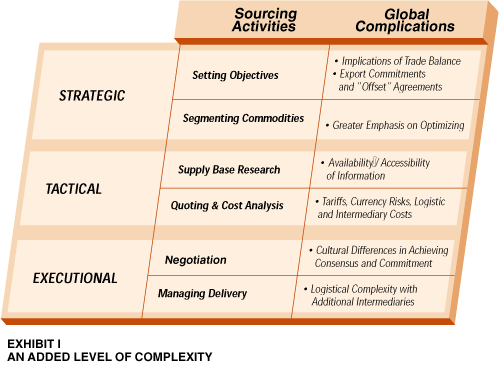
Although our research in this area is still under way, this article explores some issues in global sourcing encountered by our clients. The article is part of a series in Strategy & Business expounding upon the skills required in the business model that Booz-Allen describes as "balanced purchasing."
Strategic Considerations
Global sourcing generally refers to sourcing outside of a company's traditional market. Two quite different strategic drivers may be behind a company's desire to source globally:
![]() Global expansion into new markets often forces a company to establish a local supply base.
Global expansion into new markets often forces a company to establish a local supply base.
![]() Suppliers outside the home market may offer superior technology or low labor cost in products.
Suppliers outside the home market may offer superior technology or low labor cost in products.
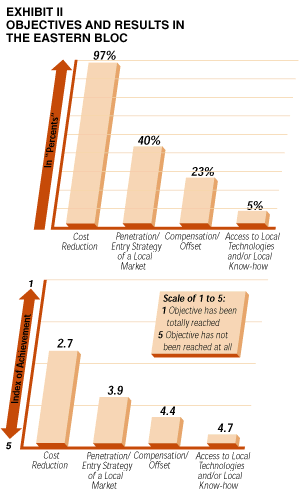 A recent study by Booz-Allen & Hamilton highlights that most of the sourcing in the former Eastern bloc has been driven by a desire for cost reduction. The need to develop a local supply base in order to penetrate the Eastern European market was a distant second (see Exhibit II). This finding is consistent with our experience in other regions as well: only a small set of truly global companies are focused on building a global supply base, while the vast majority of companies are turning to global sources because their domestic suppliers are no longer providing "world class" cost and/or technology.
A recent study by Booz-Allen & Hamilton highlights that most of the sourcing in the former Eastern bloc has been driven by a desire for cost reduction. The need to develop a local supply base in order to penetrate the Eastern European market was a distant second (see Exhibit II). This finding is consistent with our experience in other regions as well: only a small set of truly global companies are focused on building a global supply base, while the vast majority of companies are turning to global sources because their domestic suppliers are no longer providing "world class" cost and/or technology.
The two different strategic objectives influence a company's approach to global sourcing in a variety of ways. Companies focused on global expansion are more likely to have a local presence in the foreign country, and this improves their ability to execute global sourcing. For example, these companies usually employ buyers who are native to the particular country, eliminating a potential language barrier with suppliers. They also are able to take a longer view towards supplier development. However, globally expanding companies usually have more complicated strategic objectives: government relations, balance of trade and export targets must be considered in addition to insuring the lowest total delivered cost at the factory door.
But the most important effect of the different objectives is in commodity segmentation to identify the best targets for "global sourcing." A company that sources globally to import back to its home market tends to focus on small, high-value components that can be shipped economically. This global importer looks to developing countries for components with labor cost advantages in simple process technologies. In mature countries, this company usually seeks access to "world class" technology expertise.
Nike, which sources the full product rather than the components, provides an interesting example of capturing low labor cost and technological capabilities. In the past two decades, Nike has developed an extensive supply base of approximately 40 locations -- predominantly in low-wage-rate countries throughout Asia. As a result, Nike achieves a landed cost for the Pegasus running shoe in the United States of about 25 percent of the retail price. Interestingly, Nike has created an effective mix of low-cost countries with higher-cost ones. Initially, much of Nike's production was in South Korea and Taiwan, when they were considered low-cost countries. However, as wage rates increased, Nike developed new suppliers in lower-cost countries like Indonesia and China. At the same time, Nike continued to increase the technological complexity of the product with such features as air cushion inserts and multicolored soles. Accordingly, the more sophisticated suppliers in South Korea and Taiwan produce increasingly complicated products while new suppliers in countries with lower wage rates produce the simpler, high- labor products.
Conversely, a globally expanding company seeks local suppliers for the bulkiest products -- the ones that cannot be economically imported into the region. When expanding into a growth market, a company tends to select components with high labor content such as large sub-assemblies, capturing the labor cost advantages and reducing transportation cost. In expanding into mature markets, a company generally focuses on major systems that require technological sophistication but not low labor cost.
Globally expanding companies must also strive to optimize product development costs. Many companies are now trying to capture scale advantages by amortizing product development costs over global volume, based on the converging expectations of customers around the globe. Nevertheless, global sourcing decisions must balance the scale advantages of using standard designs around the globe against the potential cost advantages of "de-contenting" designs to meet cost targets and local expectations.
For example, a leading automotive company has employed a new segmentation scheme to drive sourcing decisions in support of its global expansion. Exhibit III shows the segmentation of the commodities from both a manufacturing perspective and a product development perspective.
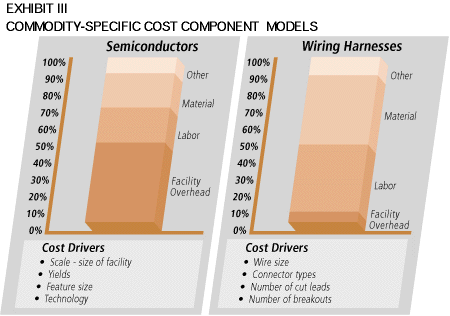
The above chart focuses on the two issues of manufacturing scale and transportation cost. Commodities plotted in the top left-hand corner of the matrix are excellent candidates for global sourcing from a single world-class supplier to serve a company's total needs. The commodities in the bottom right-hand corner are the best candidates for local sourcing in support of global expansion.
The right chart of Exhibit III adds the issue of whether a single global design should be employed instead of local specifications. The company has identified four tactics to optimize the trade-off between design standardization and local "value engineering":
![]() Where product development costs are high and the value of customized local designs is low, "carry-over" designs from the mature market are used in the emerging markets.
Where product development costs are high and the value of customized local designs is low, "carry-over" designs from the mature market are used in the emerging markets.
![]() At the opposite extreme, in the cases where the cost saving potential of customized designs is huge, the company creates new designs that meet local customer needs.
At the opposite extreme, in the cases where the cost saving potential of customized designs is huge, the company creates new designs that meet local customer needs.
![]() Where the benefit of new design is relatively low but the product development costs are also low, the company uses the original design with relaxed specifications to match the capabilities of the local supply base.
Where the benefit of new design is relatively low but the product development costs are also low, the company uses the original design with relaxed specifications to match the capabilities of the local supply base.
![]() The most critical area occurs where local design offers significant opportunity but the product development costs are high. In such cases the company has the original supplier develop a range of products using modular design principles that allow local customization with lower overall development costs.
The most critical area occurs where local design offers significant opportunity but the product development costs are high. In such cases the company has the original supplier develop a range of products using modular design principles that allow local customization with lower overall development costs.
Bringing the two segmentation schemes together provides the strategic direction. In the example provided, the client concluded that large stampings should be manufactured in the same locale as their assembly plant since there is only moderate manufacturing scale and extremely high transportation cost. Furthermore, since the new tooling would be required anyway, the incremental product development cost to "localize" the design is relatively low. On the other hand, electronic controls should be produced to a standard global design and shipped globally, since transportation cost is relatively low and product development cost is quite high.
From Booz-Allen's experience the strategic considerations highlighted here are often given inadequate attention by many companies.
Tactical Considerations
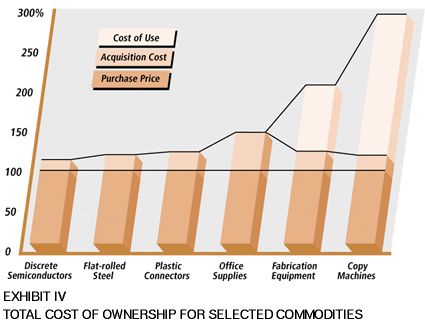
Global sourcing also adds complexity to tactical activities. One common obstacle is the unavailability and inaccessibility of information on the supply base. First, few countries have the sophisticated information infrastructure that American buyers are dependent upon. For instance, Thomas Register, the ultimate supplier reference for many buyers, does not cover Slovakia or Belarus. Fortunately, most countries have organizations that play "Chamber of Commerce" roles. Though many of these organizations have materials available in English, the likelihood of getting good information in a country improves dramatically with the ability to speak the language.
The combination of limited information with the challenge of multiple languages led one company to enlist Booz-Allen to support an expansion of sourcing into Eastern Europe. First, the team segmented the commodities to focus the research on areas that should have the greatest potential. Next, by combing the available information sources in six countries, the team identified several thousand potential suppliers of the selected commodities.
As shown in Exhibit IV, this group was culled to about 500 suppliers that appeared to warrant further investigation through a written survey. The survey requested information on a variety of topics such as quality certifications, customers in Western Europe, capacity availability and process technology.
A little less than half of this group responded to the survey. Using the survey responses, potential suppliers were sorted into three categories: green, for those with high potential; yellow, for those seen as possible suppliers; and red, for those whose candidacies were closed out. Site visits were arranged with green and yellow suppliers. The visiting team conducted basic quality audits and interviewed management teams to assess the people and processes. The site visits indicated that about 13 percent of the survey-based green and yellow suppliers were not capable. Still, nearly 90 percent of the suppliers visited were classified as green or yellow at this stage (see Exhibit V).
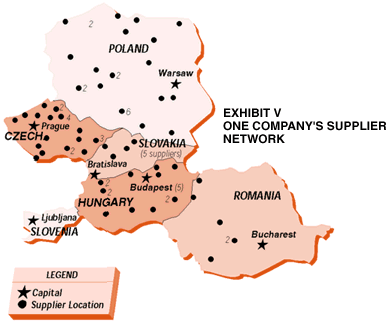
The results highlighted a major opportunity for re-sourcing, and the client has contracted with Booz-Allen to support the effort into implementation.
One tactical complexity of global sourcing comes from the need to make "apples to apples" comparisons in examining total delivered cost. These costs fall into three major categories:
![]() currency risks
currency risks
![]() tariffs
tariffs
![]() logistics and intermediary costs
logistics and intermediary costs
Properly assessing currency risk is an art that can make a trader wealthy but that generally leaves a buyer in a state of confusion or fear. The best tactic is not to try to "outguess" the traders, but simply to lock in currency exposure with forward contracts and hedging. Too many companies that should have been focused on their core businesses have lost money by speculating on currency.
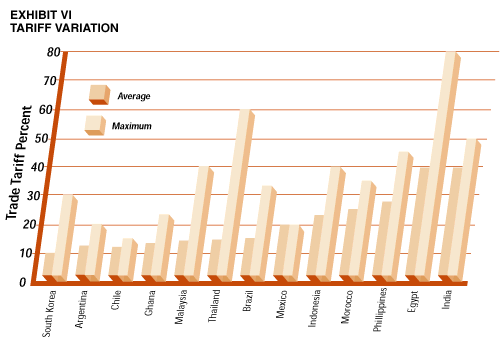
Tariffs present an additional item of complexity. As shown in Exhibit VI, the rates vary significantly by country. An even greater complexity, however, comes from variation by commodity or product classification within a country. Generally, nations impose higher tariffs on high-level assemblies or critical industries to encourage (or protect) local production. As a result, minor differences in a product's classification can have an order-of-magnitude effect on the tariff rate.
Logistics costs are usually higher when importing materials from a foreign source since the distances are generally greater. Appropriate comparisons should consider the optimal mode ( rail, truck, air or ocean freight) by considering inventory and expediting costs as well as actual transport. Global sourcing often creates additional intermediaries, such as foreign distributors, brokers, freight forwarders and customs clearing agents. Their fees are generally small individually but can be significant in total.
The tactical issues in global sourcing generally disappear with experience, but the learning curve can be expensive. Implementation issues are actually more challenging since they are often addressed through strategic decisions.
Implementation Issues
The two major implementation issues are culture and/or language and supply chain complexity. Though these issues are experienced in day-to-day execution, the best solution is often to make direct investment in people and facilities in the targeted global markets. A company that hires native resources in the region can counteract the cultural and language issues and can also simplify control of the supply chain.
Although English is generally the common language of business throughout the world, language skills vary. Many global executives can describe the sense of frustration that occurs when other participants break off into a "private" conversation in their native language during a meeting.
Even where language barriers are few, significant cultural barriers may still exist. Most business executives traveling to Japan quickly learn basic "customs" like exchanging business cards and small gifts. However, many still fall into the subtle trap in meetings of engaging with the most fluent English speaker rather than the most senior member of the Japanese team. Even the most experienced buyers struggle in negotiations in the consensus-driven cultures of Asia, where harmony is generally more important than frankness.
Complexity of the supply chain is another implementation challenge in global sourcing. As discussed earlier, a wide variety of intermediaries such as foreign distributors, brokers, freight forwarders and customs clearing agents may separate the customer from the supplier. These intermediaries add not only cost but also uncertainty to the supply chain. The multiplicative effect of these uncertainties can make a global supply chain difficult to manage. Simply tracking a shipment through each stage of the chain can be a time-consuming process.
Many companies have found that international purchasing offices are the most effective means for eliminating or controlling the many intermediaries. The international purchasing office plays two key roles. First, it provides a physical presence to manage the flow of the materials. Second, it provides the skills needed for successful global sourcing -- eliminating the need to build the skills in every buyer in the home market. However, investment in the infrastructure of an international purchasing office is significant and can be cost effective only if a significant number of purchases is managed by the region or if the company already has a significant presence in the region.
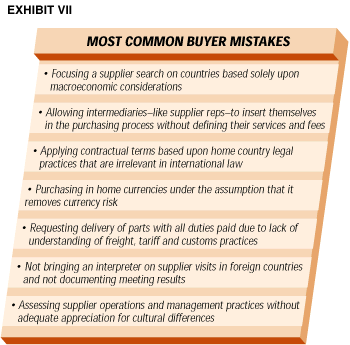
For the interested reader, practical advice on executional challenges of global sourcing can be found in the book "Global Supply Management" by Dick Locke. For example, in the first chapter Mr. Locke calls upon his experience in setting up and running Hewlett-Packard's first international purchasing office in Asia to identify the most common mistakes that buyers make in global sourcing (see Exhibit VII.)
Conclusion
There are many hurdles to overcome in global sourcing. All of the hurdles add cost or increase risk or both. As a result, many companies attempting global sourcing find the benefits are less than expected. Furthermore, ineffective global sourcing can have a detrimental effect on global expansion. An inability to build a local supply base can lead to failure of the entire business in a new market.
However, from our experience, companies that are willing to invest in building the skills to support global sourcing can be successful. It is not easy, but it can be done. More important, in industry after industry, it must be done. ![]()
Reprint No. 97301
| Authors
Timothy M. Laseter, laseter_timothy@bah.com Tim Laseter is a vice president with Booz Allen Hamilton in McLean, Va. He has 14 years of experience building organizational capabilities in sourcing, supply chain management, and e-business strategy in a variety of industries. C.V. Ramachandran, ramachandran_cv@bah.com C.V. Ramachandran is vice president in the operations practice at Booz-Allen & Hamilton and leads the firm's thinking on the impact of electronic commerce on buyer-supplier relationships. Tonya M. Leary, Tonya M. Leary is an associate with the consumer and engineered products group of Booz-Allen and is also based in the New York office. She specializes in business strategy development and business process re-engineering. |


